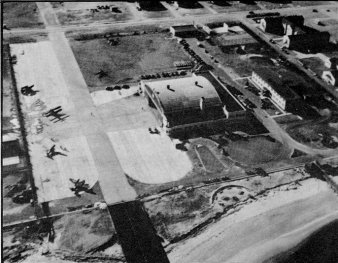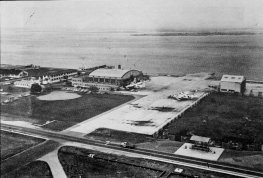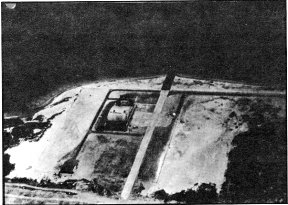 With a lease executed in January of 1936, the Coast Guard was on it’s way to opening an Air Station on Floyd Bennett Field. Dedication ceremonies were set for April 23, 1938. There were parades and public officials. Special guests were taken from the U. S. Barge Office at the Battery aboard the Coast Guard tugs Comanche and Manhattan to the sea plane landing at the field. The ceremony was conducted by Rear Admiral R- R. Waesche, Commandant, U. S. Coast Guard, who came from Washington aboard a large Coast Guard cutter.
With a lease executed in January of 1936, the Coast Guard was on it’s way to opening an Air Station on Floyd Bennett Field. Dedication ceremonies were set for April 23, 1938. There were parades and public officials. Special guests were taken from the U. S. Barge Office at the Battery aboard the Coast Guard tugs Comanche and Manhattan to the sea plane landing at the field. The ceremony was conducted by Rear Admiral R- R. Waesche, Commandant, U. S. Coast Guard, who came from Washington aboard a large Coast Guard cutter.
There was music by the Coast Guard Academy Band and luncheon was served inside the Coast Guard hangar. It was hosted by Captain Thomas M. Malloy, the Station’s first Commanding Officer, and Commodore J. S. Baylis, USCG, then Commander Third Coast Guard District, New York.
Until the outbreak of World War II, the activities of the Air Station were mainly concerned with what now has become recognized as air- sea rescue. In the early days of the War, when submarine menace was acute and combat planes were unavailable, the patrol and utility aircraft attached were armed with depth charges and served at least in a harassing capacity.
As the submarine menace subsided and combat aircraft became available to the Navy, the aid of Coast Guard aircraft was no longer needed.
By a directive from the Chief of Naval Operations, dated November 19, 1943, the station was designated a helicopter training base. Three Sikorsky HNS helicopters were assigned. Shortly after this, the British Admiralty requested that the Coast Guard train a number of pilots and mechanics for them. Four British helicopters were assigned for this purpose. A number of pilots were also trained for the USAAF, the U.S. Navy, and the C. A.A. CDR- Frank A. Erickson was placed in charge of the helicopter training and became Commanding Officer of the Air Station from December 1943 until February 1945.
The task of organizing the training unit was completed on June 1, 1944. Regular production trainers were now available in sufficient quantities to start the training of regular classes.
By the end of the first year of operations, over one hundred pilots and one hundred and fifty mechanics had been trained to fly and service these aircraft. Over 3000 hours had been flown by the HNS helicopters attached to Air Station Brooklyn.
The HNS trainers were of limited operational value, but there was one mission for which the aircraft was ideally suited. The Brooklyn Navy Yard requested that tests be run to determine the feasibility of using helicopters as targets for radar calibrations of vessels undergoing overhaul in the Navy Yard. The tests proved so successful that the Navy Yard requested that helicopters be assigned for this work from the Chief of Naval Operations.
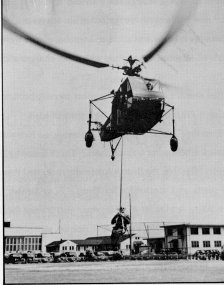 The trainers were used on several occasions for rescue and relief missions. Blood plasma was flown to the wreckage of the U. S. S. Turner after it exploded in New York harbor; a youngster was rescued from a sandbar in Jamaica Bay and fire fighting equipment was dropped to firemen fighting a blaze on a railroad trestle, when other means failed to reach the firefighters.
The trainers were used on several occasions for rescue and relief missions. Blood plasma was flown to the wreckage of the U. S. S. Turner after it exploded in New York harbor; a youngster was rescued from a sandbar in Jamaica Bay and fire fighting equipment was dropped to firemen fighting a blaze on a railroad trestle, when other means failed to reach the firefighters.
A rescue hoist was developed, as were several pickup harnesses. This equipment received its first real test at the Navy’s air-sea rescue demonstration held off Manasquan, N. J. on October 2, 1944, when 4 men were picked up from a rubber raft and landed aboard the cutter Cobb in slightly less than ten minutes.
Now and then during helicopter training little incidents occurred which livened up the routine. The following incident is as related by CDR. Erickson.
On one occasion a “nonconformist” RAF autogiro pilot was approaching for a landing in an HNS along a flight path which took him over a concrete seawall when the aircraft suddenly lost lift. Fortunately, the main landing gear hooked on the inside of the seawall so that the aircraft could not roll backwards. It just sat there rocking back and forth with its tail over the seawall. LCDR Red Lawrence rushed out of the operations office, crawled into the left seat and flew the helicopter out for him. It didn’t take long to find out the cause of the accident. The pilot was STONED! The station wardroom had a beer mess that was supposed to be closed until after working hours. The Commanding Officer was not aware of it, but some of the students were having a few after breakfast. That was the end of the beer mess.
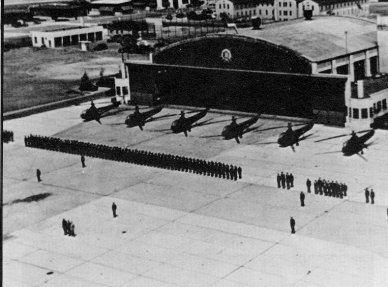 On a more serious note, on April 21, 1945, a Canadian PBY-5A had been forced down 180 miles south of Goose Bay Labrador. The Coast Guard and Army Air Forces teamed up to rescue the crew. Two men were badly burnt In the PBY when it caught fire after crashing in the wilderness. Several days passed before a USAAF C-54 spotted their distress signal. Two RCAF rescue ski planes, dispatched to the scene, landed safely. One managed to take off with several survivors. A blizzard prevented any further attempts during the next two days. When the weather cleared, the first plane returned and landed, but the snow was too soft for either plane to take off with a load, so they were flown out without passengers. The 9 men left behind would be stranded for weeks until the lakes thawed sufficiently for float planes to land.
On a more serious note, on April 21, 1945, a Canadian PBY-5A had been forced down 180 miles south of Goose Bay Labrador. The Coast Guard and Army Air Forces teamed up to rescue the crew. Two men were badly burnt In the PBY when it caught fire after crashing in the wilderness. Several days passed before a USAAF C-54 spotted their distress signal. Two RCAF rescue ski planes, dispatched to the scene, landed safely. One managed to take off with several survivors. A blizzard prevented any further attempts during the next two days. When the weather cleared, the first plane returned and landed, but the snow was too soft for either plane to take off with a load, so they were flown out without passengers. The 9 men left behind would be stranded for weeks until the lakes thawed sufficiently for float planes to land.
Fortunately, a Sikorsky HNS Helicopter was available at Air Station Brooklyn. It was disassembled, loaded on a C-54 and flown to Goose Bay. When it was reassembled, Lt. August Kleisch, USCG, flew the helicopter to a base camp that had been set up at Lake Herr about 146 miles south of Goose Bay, which could be supplied by ski planes. Kleisch had to make 9 trips into the crash site, each trip averaging an hour and a half, bringing out one man at a time. This rescue mission really showed the versatility of the helicopter.
The 1940’s saw much activity and a great deal of expansion and construction at the Air Station. Some of the new additions to the Air Station were tennis courts, a handball court, and a barracks directly across from the hangar that also housed the station galley. A large building was constructed by the Navy near the taxiways to serve as the field’s firehouse. This building, along with more buildings and land, would be acquired by the Coast Guard in the early seventies. They now house Public Works and NAFA. Also, benches and picnic tables were added to the beach to the right of the seaplane ramp. During this time period the Air Station operated helicopters and a large variety of fixed wing aircraft. Some were built for the Coast Guard, while others were still on loan from the Navy and some were confiscated during smuggling operations. The 1950’s brought about some more structural changes to the Air Station. The two quonset hut type buildings pictured at the top left of the hangar were constructed as utility buildings. In future years these buildings would house the station exchange and package store and later the enlisted men’s club. The mid-fifties were busy ones. The station operated no less than 18 aircraft of various types in 1956. To facilitate maintenance, a new ramp and new hangar were constructed. The new nose hangar was used primarily for maintenance on the PBM- 5 Martin Mariner and the main hangar for helos and other fixed wing aircraft. Also added to the left side of the main hangar was an addition that now houses the avionics shop. Also note what 11 years has done to the beach area.
The 1960’s were, of sorts, a big turning point for the air station. By the mid-sixties the only aircraft operated by the station were the HU- 16E Grumman Albatross and the new HH-52A Sikorsky Seaguard Helicopter. The U. S. Navy at Floyd Bennett Field was quickly shutting down it’s operations a section at a time until in 1971 The Naval Air Station, New York, was decommissioned. With this, the control tower and runways were also closed. With these closings and the ever decreasing water landing capabilities of the HU- 16, it left the Coast Guard no alternative but to make the station a helo-only station.
In the 1970’s, the air station operated three HH- 3F Sikorsky Pelican Helicopters and four of the HH-52A type helos. Ln 1976, the three H-3 helicopters were relocated at Elizabeth City, N.C. and three more H-52 type helos were brought in to give the station a complement of seven HH-52A helos. In 1972 the original barracks were condemned and all barracks residents were moved down the street to the brick barracks that now houses the U.S. Park Service. In 1973, the cornerstone was laid for the barracks that are in use today. The old barracks were torn down.
The 1980’s saw the retiring of the HH-52A helicopter, making way for the new HH-65A helicopters. In the future, Coast Guard Air Station Brooklyn will be going through many facelifts to keep it ready for many years to serve the public in the many missions of the Coast Guard.

